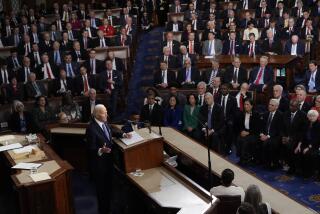Workers suddenly have more power to demand higher pay and better jobs

Workers are receiving the fattest wage increases since the Great Recession as employers struggle to find enough people to fill their ranks and employees have more leverage to demand higher pay and jump to better jobs.
Wages grew 3.4% in the past year, the government reported Friday, the fastest pace in nearly a decade and well above inflation, suggesting that employers are hustling to attract and retain workers. Many are slashing requirements for jobs and are hiring workers quickly to prevent them from being scooped up by competitors, a far cry from the days when job seekers felt lucky to even get a callback.
The unemployment rate fell to 3.8% in February, marking one year of sitting at or below 4%, a level many economists regard as “full employment” — when there are few people left who want jobs and cannot get them.
Knowing whether full employment is finally here is difficult. As “we’re hiring” signs abound, people who were not actively looking for jobs have started jumping back into the labor force, suggesting that there could be more untapped potential. Young women and Latinos have driven much of the labor-force growth recently.
But regardless of whether the nation is at the magical full-employment mark, there are clearer signs that the balance of power in the labor market is shifting toward employees.
“We’ve seen a spike in job postings that say ‘no experience necessary’ or ‘no prior experience required,’” said Julia Pollak, an economist at ZipRecruiter, a popular job site. The site has seen companies increasingly delete requirements such as a college degree or high school diploma from job descriptions.
Ron Nelsen, who runs a garage door business in Las Vegas called Pioneer Overhead Door, said a man in his late 20s showed up at the office at 7:30 a.m. recently in work pants and white T-shirt saying, “I need a job. I’m ready to go to work.”
Nelsen liked him immediately, since he had experience installing garage doors, and told him to come back for a longer interview at 2 p.m. But as the man turned to go, Nelsen changed his mind and hired him on the spot. He was afraid he would lose him to another construction company down the road before the afternoon.
“As an employer, 3.8% unemployment is not a good thing,” said Nelsen, who starts technicians at $15 an hour but said he has been bumping most workers up to about $20 within months to prevent their being hired away.
“Employers really do seem hungry for workers and prepared to do more than they did in the past to develop talent when they can’t find talent,” Pollak said.
How long the good news will continue for workers is unclear. Many forecasters anticipate a U.S. recession in the next two years, and the rest of the world economy is already slowing. And while things have picked up lately in the United States, millions of Americans are still shaking off years of stagnant wages and volatile personal finances.
“We are seeing real, fundamental improvements since 2015. But it’s against a very low threshold for many workers,” said Diane Swonk, chief economist at Grant Thornton.
Only the top 10% have fully recovered the wealth they lost in the downturn, according to research from the Federal Reserve that takes inflation into account. Parts of the country are also still experiencing rough times, and growing numbers of employers are making it more difficult for workers to take jobs elsewhere by making them sign noncompete contracts.
But many employers are becoming so desperate for people to hire that they are taking a chance on potential workers in ways they rarely did in the past.
IBM will often hire top MBA students and recent PhDs in science or math fields even if there are no immediate specific jobs for them, company chief economist Martin Fleming said, because executives know they are competing for talent with Google, Facebook and other technology giants.
Tech companies have struggled for a while to find highly skilled employees, but competition has picked up for lower-skilled workers lately, too. The unemployment rate for workers without high school diplomas fell to 5.3% in February, a record low since the Labor Department began tracking that statistic in 1992.
Wages for workers who are not in management positions are growing faster — at a rate of 3.5% — than the overall trend, another indication of increased competition for workers at the lower part of the income scale.
Costco announced this week that it is raising pay for its entry-level workers to $15 an hour — up a dollar from an increase nine months ago. Nineteen states also raised their minimum wages in January, helping to boost pay for many workers in retail and hospitality sectors.
“People are coming from the sidelines straight into employment,” said Marianne Wanamaker, an associate professor of economics at the University of Tennessee and a member of President Trump’s American Workforce Policy Advisory Board.
Wanamaker points out that 72% of new hires came from outside the labor force, meaning an unusually high share were not even hunting much for jobs in the past month when employers lured them in.
The United States has had more job openings than unemployed people since June, forcing employers to be more creative in their searches.
Trump has been under pressure from business owners and some Republicans in Congress to expand programs for temporary workers from abroad. Despite his hard-line immigration position, Trump has spoken, on occasion, about recognizing the need for foreign labor in a tight job market.
In a speech this month to the Conservative Political Action Conference, Trump boasted about the low unemployment rate and said: “I got all these companies moving in. They need workers. We have to bring people into our country to work these great plants that are opening up all over the place.”
But Trump has shown little action on that front. In addition to cracking down on illegal immigration, the Trump administration has tightened restrictions on legal channels for entry to the country, including the H-1B visa program that allows temporary employment of highly skilled foreign workers.
Inflation has been a modest 1.6% in the past year, according to the Commerce Department, meaning wages for most workers are growing well above the increase in the cost of living.
Federal Reserve leaders have indicated they believe that even with the unemployment rate so low, there may still be room for more hiring. The central bank is holding off on raising interest rates any higher in the hope that even more people can get back to work.






